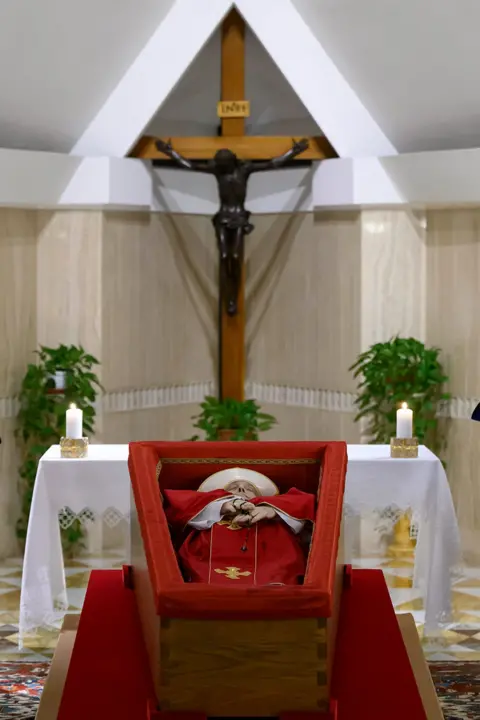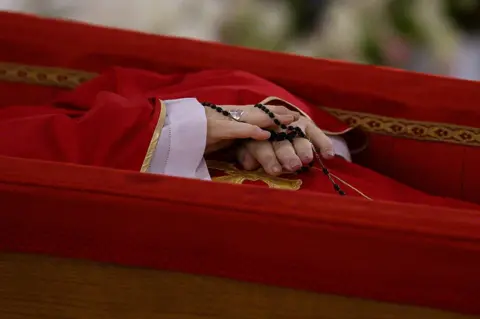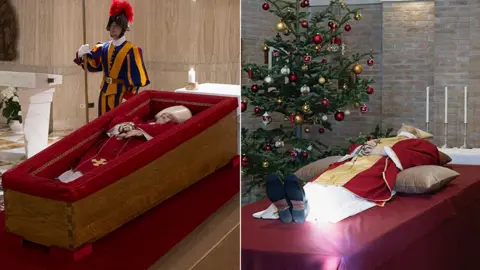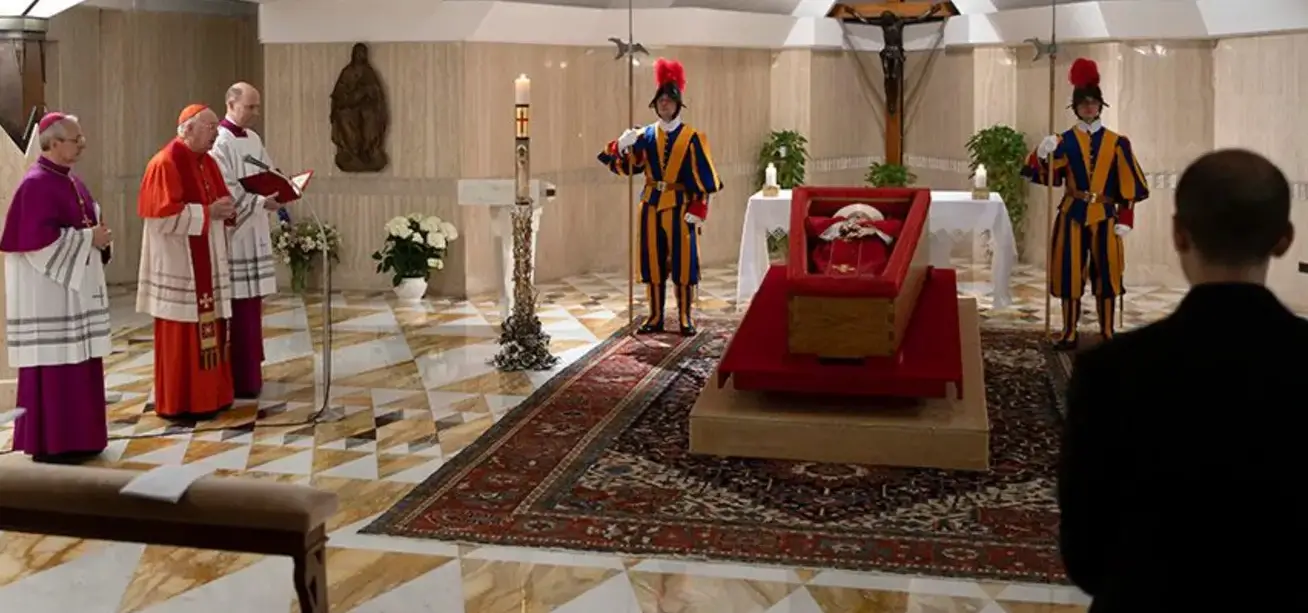NOTE:VIDEO AT THE END OF ARTICLE.
Pope Francis Lying in State at Casa Santa Marta: A Detailed Look at the Ceremony and Its Symbolism
On the morning of April 22, 2025, the Vatican released the first official photographs of Pope Francis lying in an open wooden coffin within the intimate confines of the Casa Santa Marta chapel—his chosen residence since the beginning of his pontificate in 2013. This unprecedented glimpse captured not only the late pontiff’s final repose but also a carefully considered arrangement of vestments, regalia, and architectural symbolism, all reflecting his lifelong commitment to humility, simplicity, and pastoral care. Below, we examine the key figures present, the meaningful deviations from past papal funerary customs, and the rich visual symbolism displayed in the chapel.

1. Background: From Jorge Mario Bergoglio to Pope Francis
Born Jorge Mario Bergoglio in Buenos Aires on December 17, 1936, Pope Francis was the first pope from the Americas and the first Jesuit ever elected to the papacy. His twelve-year tenure was marked by an emphasis on social justice, outreach to the marginalized, and a reformist stance toward Vatican bureaucracy. Eschewing the traditional papal apartments, he chose to reside in the Domus Sanctae Marthae—a modest guesthouse within the Vatican complex that houses clergy and visiting cardinals—reinforcing his message of solidarity with ordinary priests and minor clergy.

On April 20, 2025, following a stroke-induced coma, the Holy Father passed away peacefully at Casa Santa Marta. As per his wishes, the ensuing rites were designed to reflect the same simplicity and pastoral humility that characterized his papacy.
2. The Rite of Certification of Death
Shortly after his passing, Cardinal Kevin Farrell—an Irish‑American prelate serving as camerlengo—presided over the formal rite of certification of death. Cloaked in the scarlet mozzetta and cassock that signify his office, Cardinal Farrell carried out a ritual dating back to medieval times, officially confirming the Pope’s death and temporarily assuming stewardship of Vatican governance until a successor is chosen. His presence in the images underscores the continuity of centuries‑old papal protocols, even amid Francis’s push toward modernization.

3. Vestments and Regalia: A Study in Contrast
In each photograph, the late pontiff lies serenely dressed in red liturgical vestments—a hue traditionally associated with martyrdom and the sacrificial role of a bishop. Draped across his shoulders is the red ferraiolo, and at his feet rests the simple papal pallium. On his head sits the papal mitre, resplendent in white, symbolizing the yoke of Christ.

Yet two details stand out as emblematic departures from prior papal funerary practices:
-
The Silver Ring: Rather than the ornate Fisherman’s Ring—engraved with an image of St. Peter casting his net and routinely destroyed by the camerlengo after a pope’s death—Francis is shown wearing the unadorned silver ring he often favored. This plain band, marked only by a modest cross, served as his daily symbol of office, reflecting his insistence on accessible, unpretentious spiritual leadership.
-
The Wooden Coffin: In sharp contrast to the three nested coffins of cypress, lead, and oak used for his predecessors, Francis specified a single, simple wooden casket. Its unvarnished interior and minimalist design echo his enduring advocacy for solidarity with the poor and his lifelong identification with the most vulnerable.
4. Architectural and Artistic Symbolism in the Chapel
The chapel of Casa Santa Marta, completed in 1996, was originally intended to accommodate cardinals during the conclave. Its design, however, incorporates profound theological symbolism that resonated deeply with the late pontiff’s own convictions:
-
Trinitarian Geometry: Throughout the chapel—on the ceiling coffers, the floor tiles, and even the slender columns—triangular motifs abound, each triangle evoking the mystery of the Holy Trinity (Father, Son, and Holy Spirit). This pervasive design choice invites both liturgical participants and silent observers to contemplate the triune God at every glance.
-
Latin Inscription: Above the altar, carved into the pristine white masonry, is the phrase Veni, Sancte Spiritus, reple tuorum corda fidelium (“Come, Holy Spirit, fill the hearts of your faithful”). This invocation to the Spirit encapsulates Francis’s constant appeal to divine inspiration in the Church’s mission of mercy and outreach.
-
Intimate Scale: Unlike the soaring vaults of St. Peter’s Basilica, the chapel’s modest dimensions foster a sense of closeness—an architectural reflection of Francis’s pastoral style, which prioritized individual encounter and dialogue over hierarchical grandeur.
5. Guardianship of the Swiss Guard
Flanking the coffin are members of the Pontifical Swiss Guard, dressed in their iconic Renaissance‑era uniforms of blue, red, orange, and yellow stripes. First recruited in 1506 by Pope Julius II, the Swiss Guard has protected the pope for over five centuries. Their silent vigil over Francis’s remains symbolized the unbroken chain of loyalty and service that binds the Vatican’s defenders to the successor of St. Peter.
6. Timeline for Transfer and Lying‑in‑State
According to Vatican announcements, Pope Francis’s body remained in the Casa Santa Marta chapel through the morning of Wednesday, April 23. At precisely 09:00 local time, a solemn procession—comprising clergy, members of the Swiss Guard, and close aides—carried the coffin through the Vatican Gardens to St. Peter’s Basilica. There, an open casket was installed in the nave, allowing the faithful to file past and pay tribute.
This public lying‑in‑state continued through Friday evening, concluding with vespers led by the Dean of the College of Cardinals. On Saturday morning, April 26, the funeral Mass was celebrated by Cardinal Angelo Sodano, the senior cardinal-bishop, in St. Peter’s Square, where tens of thousands gathered beneath overcast skies, joined by multinational delegations and heads of state.
7. Global Response and the Road to a New Conclave
News of Francis’s passing reverberated around the world: church bells tolled in Rome, parishes in Manila and Lagos held candlelit vigils, and flags flew at half‑mast in predominantly Catholic nations. In Argentina, football club San Lorenzo—long supported by the Pope—held a heartfelt commemoration in their chapel, players donning special jerseys for their next match.
As tradition dictates, the College of Cardinals entered a nine‑day period of mourning (the novendiales), during which all Vatican administrative decisions were suspended. The camerlengo maintained daily oversight, while cardinals from across the globe began to converge on Rome, preparing for the secret conclave that would elect the 267th pope.
8. Francis’s Enduring Legacy
Pope Francis’s funeral rites—marked by simplicity, symbolism, and a careful balance of tradition and innovation—offered a fitting coda to a papacy that challenged the Church to reconsider its relationship with power, wealth, and the environment. His decision to forego pomp in favor of pastoral authenticity left an indelible imprint on Vatican ceremony and Catholic consciousness alike.
-
Liturgical Reform: Francis’s choice of vestments and burial vessel underscored his plea for a “poor Church for the poor,” influencing the way future pontiffs might navigate the tension between reverence and relevance.
-
Architectural Embrace: By living and dying in Casa Santa Marta rather than the Apostolic Palace, he redefined the locus of papal presence—favoring communal living and modest quarters over secluded magnificence.
-
Ecumenical and Interfaith Outreach: The guest list for his funeral reflected decades of bridge-building—from Orthodox patriarchs to Protestant leaders—underscoring his vision of a Church in dialogue rather than in isolation.
As the conclave dawned, cardinals carried with them not only the weight of tradition but also the memory of a pope who transformed ceremony into service and liturgical objects into tools of solidarity. Though the world now awaits the election of his successor, the images of Francis lying in repose at Casa Santa Marta will endure as a poignant testament to a life—and a legacy—rooted in simplicity, mercy, and unwavering devotion to the least among us.
@aljazeeraenglish The Vatican has released the first images of Pope Francis in an open coffin in the chapel of Casa Santa Marta, the residence where he died on Monday. #news #Popefrancis #Vatican

Adrian Hawthorne is a celebrated author and dedicated archivist who finds inspiration in the hidden stories of the past. Educated at Oxford, he now works at the National Archives, where preserving history fuels his evocative writing. Balancing archival precision with creative storytelling, Adrian founded the Hawthorne Institute of Literary Arts to mentor emerging writers and honor the timeless art of narrative.
